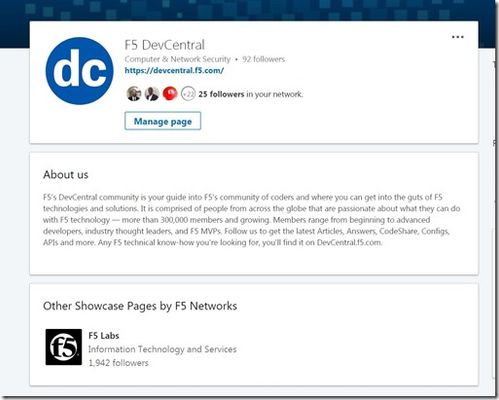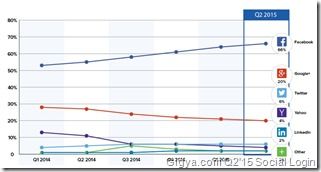Social
7 TopicsAny F5/DevCentral tattoos out there?
Hi all, Wondering if anyone else out there has inked their body with a tattoo referencing F5 or DevCentral? I chose to get a DevCentral MVP logo (with red F5 ring) since it means a great deal to me to be honored with the designation. Now I'm curious if anyone else has felt the need to make a permanent reminder of their F5 or DevCentral journey. On my arm the lines are straight but this pic seems to slant some of them. This is pre touch-up as well. Anyone else want to post theirs?323Views10likes7CommentsDevCentral Showcase on LinkedIn
We are excited to share our New LinkedIn Home! We're thrilled to be Showcased under F5's LinkedIn Company Page and look forward to building a fun place to converse, ask questions and get inside advice on BIG-IP tips and tricks. LinkedIn Showcase pages are extensions of our LinkedIn company page and allows us to highlight some of the cool stuff happening on DevCentral. You can also find the F5 Labs showcase page in the same area. This allows you, if interested, to follow the specific F5 entities that you are interested in. And, the content is tailored for your interests. Like our community, we'll be sharing How-to articles, checking out interesting codeshares and provide a sounding board for your BIG-IP adventures. We'd love to hear from you...all the goods and not so goods...and we're here to help. If you're following the F5 DevCentral Group on LinkedIn, we'd love if you'd also follow the Showcase page since we'll be focusing on growing & engaging with that community. Plus, the DevCentral Group page is linked on our Showcase so you won't miss anything. Please come join our Showcase page and let us know how we can help. Thanks! The DevCentral Team.289Views0likes0CommentsCalling All Conversations!
Is what I wrote almost 10 years ago when F5 was rolling out some of our early social media channels as the medium started to explode. Back then, we listed our MySpace, Facebook, Twitter and YouTube channels - the four big ones at the time. A decade later, Social has become one of the primary megaphones for folks not only to share but also receive content and information from a variety of sources. Today, DevCentral has a number of social outlets to engage with you wherever you like. You can follow us on twitter, subscribe and watch videos on our YouTube Channel, ask questions on Reddit, get Code on Github, follow BIG-IP discussions on Stack overflow, participate on the F5 Facebook page and follow articles on the F5 DevCentral LinkedIn Group. And, while the paint still wet, we are excited to announce our New LinkedIn Home! We're thrilled to be Showcased under F5's LinkedIn Company Page and look forward to building a fun place to converse, ask questions and get inside scoops on BIG-IP tips and tricks. Please follow and let us know how we can help. When DevCentral started back in 2003, it was one of the original ‘social’ community sites when social media was still in its infancy. F5’s DevCentral community is your guide into F5's community of coders and where you can get into the guts of F5 technologies and solutions. Members range from beginning to advanced devs, industry thought leaders, and F5 MVPs. Let us know where else you like to technically hang out and where should we be more active? Hit us up with the hash, #whereisdevcentral and we'll meet you there ps Related: Get Social with DevCentral Calling all Conversations (The Original)238Views0likes0CommentsGet Social with DevCentral
That title sounds so 2009 but let’s go with it anyway. #Flashback…no, #Throwback…no, how about #TinkerTuesday? Is there such a thing? (There is.) #DevCentral will be ramping up our social activities in 2018 and we wanted to share some of the media channels you can join to stay connected and engaged with the community. Did you know that the Twitter bird has a name? It’s Larry. And while dc’s blue ball logo doesn’t have a name, you can find your @devcentral team members @psilvas, @jasonrahm, and @JohnWagnon on twitter sharing their technology insights along with some personal daily happenings and thoughts. Stay connected for new articles, iRules, videos, the Agility Conference and earn additional DevCentral points for answering the question of the day! Don’t feel like reading anything and prefer to watch stuff? Then head on over to our YouTube channel for hours of instructional videos from our ‘Make it Work’ series, cool tech tips along with the awesome Lightboard Lessons. Lightboard Lessons are one of our most popular pieces of content and by subscribing to our channel, you’ll get the first alerts via email that a new video has published. You’ll probably even get to watch the video before it even posts to DevCentral. That’s right, early access. Prefer to hang out with the LinkedIn crowd? While the F5 Certified! Professionals LinkedIn group is very active, the F5 DevCentral LinkedIn Group has been a little dormant recently so we’re looking to gear that up again also. With a little over a 1000 members, it’s a great way to converse with other members as we march toward the 12,000+ participants in Ken’s group. When DevCentral started back in 2003, it was one of the original ‘social’ community sites when social media was still in its infancy. Members range from beginning to advanced devs, industry thought leaders, and F5 MVPs. I’m also aware that there are BIG-IP discussions on Stack overflow, repos on github, the F5 Facebook page, MVP Kevin Davies’ Telegram F5 Announce and others. Where else should we engage with you and where should we be more active? Hit us up with the hash, #whereisdevcentral and we'll meet you there. ps332Views0likes0CommentsSocial Login to Enterprise Apps using BIG-IP & OAuth 2.0
Password fatigue is something we’ve all experienced at some point. Whether it’s due to breaches and the ever present, ‘update password’ warnings, the corporate policy of a 90-day rotation or simply registering for a website with yet another unique username and password. Social login or social sign-in allows people to use their existing Google, Twitter, Facebook, LinkedIn or other social credentials to enter a web property, rather than creating a whole new account for the site. These can be used to authenticate, verify identity or to allow posting of content to social networks and the main advantage is convenience and speed. With v13, BIG-IP APM offers a rich set of OAuth capabilities allowing organizations to implement OAuth Client, OAuth Resource Server and OAuth Authorization Server roles to implement social logins. Let's look at BIG-IP’s capabilities (from the user's perspective) as an OAuth Client, OAuth Resource Server. We’ll navigate to our BIG-IP login screen and immediately you’ll notice it looks slightly different than your typical APM login. Here, you now have a choice and can authenticate using any one of the 4 external resources. Azure AD Enterprise and AD B2C along with Google and Facebook. Google and Facebook are very popular social login choices - as shown in the initial image above - where organizations are looking to authenticate the users and allow them to authorize the sharing of information that Google and Facebook already have, with the application. In this case, we have an application behind BIG-IP that is relying on getting such information from an external third party. For this, we’ll select Facebook. When we click logon, BIG-IP will redirect to the Facebook log into screen. Now we’ll need to log into Facebook using our own personal information. And with that, Facebook has authenticated us and has sent BIG-IP critical info like name, email and other parameters. BIG-IP has accepted the OAuth token passed to it from Facebook, extracted the info from the OAuth scope and now the application knows my identity and what resources I’m authorized to access. We can do the same with Google. Select the option, click logon and here we’re redirected to the Google authentication page. Here again, we enter our personal credentials and arrive at the same work top. Like Facebook, Google sent an authorization code to BIG-IP, BIG-IP validated it, extracted the username from the OAuth scope, passed it to the backend application so the application knows who I am and what I can access. Let's look at Microsoft. For Microsoft, we can authenticate using a couple editions of Azure AD – Enterprise and B2C. Let’s see how Enterprise works. Like the others, we get redirected to Microsoftonline.com to enter our MS Enterprise credentials. In this instance, we’re using an account that’s been Federated to Azure AD from another BIG-IP and we’ll authenticate to that BIG-IP. At this point that BIG-IP will issue a SAML assertion to Azure AD to authenticate me to Azure AD. After that, Azure AD will issue an OAuth token to that BIG-IP. BIG-IP will accept it, extract the user information and pass it to the application. Finally, let’s see how Azure AD B2C works. B2C is something that companies can use to store their non-corporate user base. Folks like partners, suppliers, contractors, etc. B2C allows users to maintain their own accounts and personal information. In addition, they can login using a typical Microsoft account or a Google account. In this case, we’ll simply use a Microsoft account and are directed to the Microsoft authentication page. We’ll enter our personal info, the servers communicate and we’re dropped into our WebTop of resources. Social logins can not only help enterprises offer access to certain resources, it also improves the overall customer experience with speed and convenience and allows organizations to capture essential information about their online customers. ps Related: What are social logins? The Most Popular Social Logins Globally [Infographic] Understanding the Benefits of Social Login – How does it add value to your website?875Views0likes0Comments






